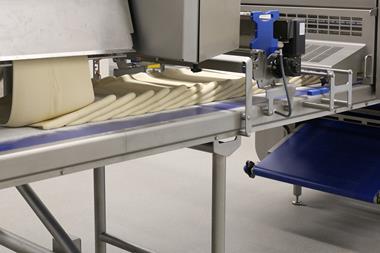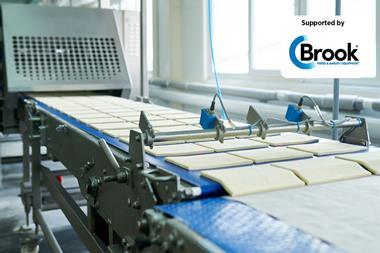Choosing the right mixer can reap rewards for bakery businesses in terms of product quality and cost savings, finds Tracy West
Download a pdf of this report here
To make a really good meringue, you either need very strong arms or a very good mixer. And when you make meringues for a living, the latter is certainly the much more practical option.
Alex Hoffler and Stacey Gorman, aka the Meringue Girls, first began creating their signature meringue ‘kisses’ in Hoffler’s kitchen, before renting a shared commercial space to help them cope with the increasing number of orders.
Today they supply the likes of Selfridges, Fortnum & Mason and Harvey Nichols, run a weekly stall at Broadway Market, and provide meringues for their own bespoke catering service.
The volumes involved mean that using the right equipment has been crucial and, for the Meringue Girls, that means a Buffalo Planetary Mixer.
“The process of making basic meringues is actually relatively simple,” explains Hoffler. “All you need is two key ingredients and a good mixer. And what’s great about the Buffalo is that it’s reliable and easy to use. It has proved robust enough to cope with endless batches of meringue – whipping the mix really well and producing consistent results every time – crucial when you’re making thousands every day.”
The Buffalo was such a hit with the Girls that they invested in a second mixer. “The large 20-litre capacity has been vital in allowing us to continue to expand the business,” explains Gorman. “Each batch produces between 200 and 300 meringues, with both mixers whipping up as many as nine batches a day. That’s a lot of meringue, so we need equipment that can keep up.”
The Meringue Girls bought their equipment from Nisbets. The business offers a range of mixers including the KitchenAid that, according to brand manager Heather Beattie, is used by many customers for small-batch experimentation. They may then upscale the recipe to a more commercial quantity, through to large quantity Buffalo Planetary Mixers, which are available in 10-, 20- and 30-litre sizes.
Smaller mixers can be helpful when it comes to new product development (NPD), says David Marsh, managing director at catering equipment supplier Benier (UK).
“The challenge here is to be able to mimic the higher-capacity mixer already installed in the production line when ‘upscaling’,” he adds.
with variable speed drives and interchangeable tools, so they can be configured to match the larger production mixers. In this way tests and trials can be done in smaller quantities off-line with a high level of confidence that the results can be achieved on the production line.”
When choosing a mixer, Nisbets’ Beattie says bakers should seek out products that include: a lever-operated bowl lift: more than one speed setting to ensure it’s suitable for a variety of tasks; and models that include a safety stop if the bowl or guard is not correctly in place.
“It is also worth investigating the accessories that are supplied with the actual mixer. Buffalo mixers include a dishwasher-safe bowl, whisk, dough hook and beater attachments,” she explains.
Power is important too and, according to Neil Richards, managing director at supplier Metcalfe Catering Equipment, the horsepower you need is defined by how much you mix, its consistency and how often you mix it.
“Horsepower is key,” he says. “Too powerful a mixer and you’ll end up with a large mess, and too weak a mixer will leave jammed gears and frustrating repairs, so make sure you take into account what you’re mixing when choosing horsepower.
“Where bulk amounts of dough are made at one time, a two- to three-horsepower motor is the best option, because it will stall less when the dough reaches its thickest consistency,” he adds. “For other applications in large batches, such as thin batters, or items that don’t reach a very solid consistency over time, a one- to two-horsepower motor would be fine. And lastly, for simple medium-to-small batches of batters, any horsepower at or below one will work.”
Benier’s Marsh says energy savings are something people always want when making an investment in new equipment.
“Mixers are all about energy. They use the power of an electric motor, driving a mixing tool, to first blend and then develop doughs or aerate batters. Waste energy produces heat and, when looking at a new mixer, dough temperature rise during mixing is a good indicator of how efficient the mixing process is from an energy-usage perspective.”
He adds that some mixing processes, such as CBP (Chorleywood Bread Process), demand very quick blending and dough development and these use higher-capacity motors with high rates of dough temperature rise, or added dough cooling.
“Used mainly in high-capacity production lines, these are less energy-efficient at the mixing stage, but often have other energy-related benefits later in the baking process,” says Marsh. “The only exception to this is high-pressure hydration of flour, where the energy is consumed by a high-pressure water pump that is used in conjunction with a purpose-designed nozzle to ‘wet’ flour as it falls through the high-velocity spray, as happens with the Diosna ContinoJet (see At a Glance panel p29).
European Process Plant (EPP) managing director Steve Merritt says VMI’s new Kneadster ‘smart’, balanced mixer is suitable for all types of dough, including highly hydrated doughs. “The VMI design engineers concentrated on the design of the tools to ensure the dough is properly oxygenated without overheating. This helps to ensure the taste of the finished loaf is first-rate.”
Merritt says many people blame highly intensified kneading for producing a poorer-tasting product.
“But it’s down to the shape, diameter and position of the tools in the bowl. VMI has invested heavily in research to ensure the dough does not become overheated and that the end result is a consistent homogenous mix.”
Meanwhile, Marsh says the most common reasons for waste at the mixing stage are either from incorrect weighing or metering of ingredients, or from missing an ingredient out altogether.
“However, many industrial mixing systems come complete with ingredient weigh frames and metering built in and the potential user should consider the accuracy of this system, its ability to be calibrated, together with its ability to store and modify recipes in a secure but easily accessible way,” he says.
When buying any new equipment, it’s important to think about the return on investment. Marsh says this can be measured in improvements to product quality and consistency to meet market needs or by improving production efficiency to reduce costs.
“Which of these is the most important is very particular to an individual baker’s needs,” he explains.
And whatever requirements a baker needs to add to the mix, there’s a machine out there for the job.
Mixers at a glance
Escher Twin Arm Mixer
Escher’s new Twin Arm removable bowl spiral mixer has been designed for the more industrial end of the market and is suitable for all types of dough.
- Features include:
- A double kneading tool
- Patented bowl locking and motion system
- Up to 3% extra water absorption
- Up to 20% shorter
- Mixing times
- Oil-free tool transmission
- Variable drive control and quick tool-change systems
- A bottom discharge system.
It is suitable for doughs including ones with low water absorption and is manufactured in hygienic stainless steel for easy cleaning.
The mixer is available from UK distributor Mono Equipment.
MDD from Benier
Benier’s high-capacity mixers have undergone a radical redesign to further improve general hygiene and quick access for maintenance and clean-down.
The MDD range was already available with CIP cleaning systems and quick-change tool designs, but has been further enhanced to speed up the clean-down cycles and allow better access to critical parts.
These CBP (Chorleywood Bread Process) mixers are rated at up to 4.5 tonnes of dough/hr and are usually supplied fully integrated with ingredient weigh and measurement systems, with all controls fully integrated into the mixer top frame. Benier claims the integrated drive design makes them the quietest mixers of their type currently on the market.
Continojet from Diosna
Diosna’s ContinoJet flour hydration system is being used in more applications, says the supplier, adding that its improvement in flour hydration versus ‘standard’ mixing systems brings rewards in product consistency, quality and cost.
It is available in the UK from Kaak Group subsidiary Benier (UK), whose managing director David Marsh says: “We have seen applications where ContinoJet has improved hydration from between 9% to 15% over the previous established mixing process. Furthermore, this hydration produces a creamier, more stable dough or batter mix.”
The patented system can be supplied to produce a pre-dough to existing mixers or supplied as part of Diosna’s ContinoMIXX continuous mixing system.
VMI’s the Kneadster
European Process Plant (EPP) has unveiled an advanced dual-tool mixer, designed to meet the needs of British and Irish plant and industrial bakers.
Manufactured by VMI, the Kneadster is said to guarantee the same results as VMI’s single-fork mixer, but in a shorter time.
An increase in the diameter of the tools allows for slower, gentler kneading. EPP managing director Steve Merritt says the new ‘smart’, balanced mixer is suitable for all types of dough including highly hydrated ones.
The Kneadster, which is claimed to be more reliable and offer reduced energy consumption, is available in two versions with dough capacities of 250kg and 450kg.
Case Study: Traybakes
Sometimes you’re lucky enough to hit the jackpot first time with a piece of kit that suits you and your business.
That was the case for Justine Carruthers, managing director at Penrith-based cake company Traybakes, who says they still use the very first Hobart mixer she bought 26 years ago, which was second-hand and purchased from a local school when they were upgrading their equipment.
“It is still in good working condition and must be 30-plus years old,” she explains.
Traybakes’ recipes are made in small batches using traditional methods, mainly by hand, but the company uses mixers for creaming butter and sugar.
“For this we use the smallest of the Hobart mixers, the A200 which is 20-litre, and we also have three of the Hobart HSM30s which are 30-litre mixers, which give more room for volume in recipes that need more space, such as ones that use the foaming method.
“I have had very few problems with Hobart mixers. They are very low maintenance and they have an excellent steel gearbox, which is very strong and hardwearing. When our local service engineer comes to service our other equipment, we always ask him to check our mixers but they rarely need any maintenance.”
Carruthers says that, on one occasion, she was tempted into buying a cheaper mixer, which was a copy of a Hobart.
“But I very quickly regretted it, because within the first few weeks a part broke off and I was told it was not covered by the warranty. I learned a lesson and have only purchased Hobart since.”





























No comments yet